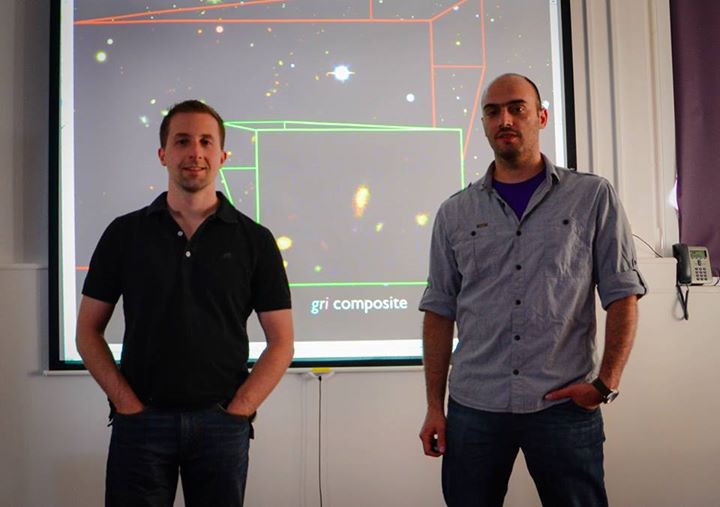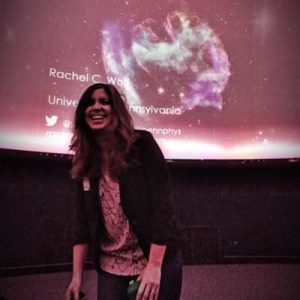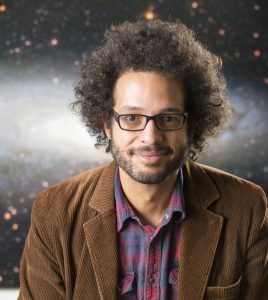This paper is about the discovery and study of DES13S2cmm, a superluminous supernova that exploded in a galaxy 7.8 billion light-years away. Supernovae are exploding stars that can outshine the galaxy in which they live and that can radiate more light in a few weeks than our Sun during its entire lifetime. Supernovae can be used to measure how fast the fabric of space-time is expanding, and they were critical in the discovery of dark energy—the phenomenon thought to be accelerating the expansion of the Universe.
Superluminous supernovae are those that are brighter, and last for a longer time, than their typical peers. However, we don’t yet know the full mechanisms underlying this difference. Over the last decade, telescopes around the world have discovered several thousand supernovae, but only 50 superluminous ones. These less-explored, extra-bright objects can provide clues to the astrophysics of massive stars, which are thought to be the first stars that formed in the Universe. Their extreme luminosities could allow us to “see” further back to the expansion history of the Universe and study the nature of dark energy.
Superluminous supernova DES13S2cmm was discovered in August 2013 as the Dark Energy Survey (DES) began its five-year observing plan, and it was visible six months later, mid-February 2014, when the first observing season ended. A normal supernova’s light usually gets bright quite quickly and then fades gradually, over the course of days, weeks or months. The change in brightness over time for DES13S2cmm was not behaving as expected: after reaching maximum light (centre image), the explosion was fading away more slowly than other superluminous events: this is a strange object, even compared to other extra-bright supernovae. Using the high-quality photometric data of DES and six months of observations, we were able to measure DES13S2cmm’s total brightness light curve. We use this superluminous event to search for the mechanism that could produce such a rare cataclysm, and as a template for future searches of super luminous supernovae.

Left panel: Deep colour template image of the area around DES13S2cmm, taken in December 2012. Yellow arrow indicates the galaxy in which the supernova exploded. Center panel: Search image of the same area as left panel, taken close to maximum light on 28-Sept-2013. Pointer indicates the position of the supernova (3 pixels away from the host galaxy) Right panel: Difference image produced after subtracting the template image from the search image, which is also the process used by computer algorithms in rolling supernova searches like the Dark Energy Survey.
About the Paper Authors

Chris D’Andrea (left) and Andreas Papadopoulos (right)
Andreas Papadopoulos is in his final (4th) year of his PhD studies at the Institute of Cosmology and Gravitation (ICG), University of Portsmouth. His research interests are focused on the physics of Superluminous supernovae, lensed supernova and supernova Cosmology. In his spare time he likes watching movies, playing soccer/basketball, stargazing & photography.
Chris D’Andrea is a supernova cosmologist at the Institute of Cosmology and Gravitation (ICG) at the University of Portsmouth, where he has been a postdoctoral researcher working with Professor Bob Nichol since August 2011. His research interests include supernova progenitors, supernova explosion mechanics, and studying their effects on their surroundings. When he’s not studying supernovae, Chris enjoys playing board games, singing karaoke, and playing softball.
About The DArchive Authors & Editors

Rachel C. Wolf is an astrophysics PhD candidate at the University of Pennsylvania. She is primarily interested in how to best use Type Ia supernovae to understand more about the evolution of our universe. Most of her work has focused on studying correlations between supernova brightness and host-galaxy properties and on creating new statistical techniques to compare observational data to cosmology theory. Rachel is also very passionate about science education and public outreach. She is involved in many projects in the Philadelphia community and serves as one of the co-coordinators of Education & Public Outreach for DES.

Brian Nord is a post-doc at Fermi Accelerator National Laboratory. He did his graduate work on galaxy clusters and simulations of large-scale structure at the University of Michigan. He has been working with the DES strong lensing group for the past 3 years. Nord is also one of the co-coordinators of Education & Public Outreach for DES. Nord also does time lapse photography and has an encyclopedic memory of movies and television from the 1980’s.